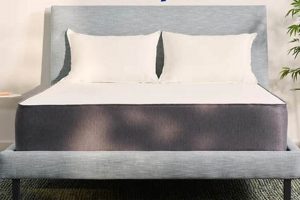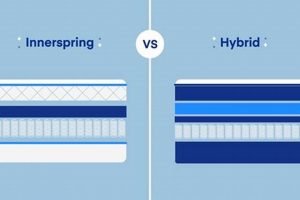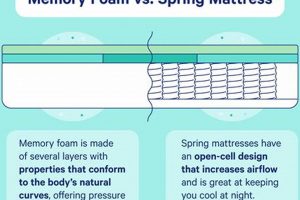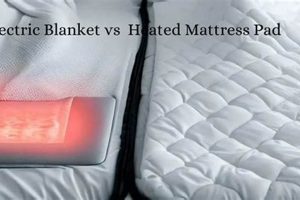The degree of support and cushioning offered by a sleep surface significantly impacts sleep quality. Options such as those that fall between moderate softness and notable firmness provide varying levels of body contouring and spinal alignment. These differing characteristics cater to a diverse range of sleeper preferences and physical needs. For example, individuals seeking a balance between pressure relief and back support may find mattresses in this range particularly appealing.
Selecting a mattress that adequately supports the body’s natural curvature can contribute to improved sleep posture and reduced musculoskeletal discomfort. The correct sleep surface can play a vital role in promoting restorative sleep, ultimately affecting daytime energy levels and overall well-being. Historically, the development of mattress technology has focused on achieving optimal comfort and support, with numerous variations designed to accommodate different body types and sleep styles.
This article will delve into the nuances between these options, outlining the key differences and helping potential buyers determine which one best suits their specific requirements. Factors such as body weight, sleeping position, and individual comfort preferences will be explored to provide a comprehensive understanding of how to choose the ideal sleep surface.
Choosing the correct mattress firmness is essential for optimizing sleep quality and minimizing discomfort. The following tips provide guidance for making an informed decision between medium and medium firm options.
Tip 1: Assess Body Weight: Individuals with a higher body weight may benefit from a medium firm option. The added support can prevent excessive sinking, promoting proper spinal alignment. Conversely, individuals with lower body weight might find a medium option more comfortable due to its increased cushioning.
Tip 2: Consider Primary Sleeping Position: Side sleepers typically require more pressure relief at the shoulders and hips. A medium mattress may provide adequate contouring. Back and stomach sleepers often require firmer support to prevent spinal misalignment, making a medium firm mattress potentially more suitable.
Tip 3: Evaluate Existing Aches and Pains: Individuals experiencing back pain may find relief with a medium firm mattress that offers enhanced lumbar support. Those with joint pain may prefer a medium mattress for its ability to reduce pressure points.
Tip 4: Review Mattress Construction: Different mattress types (e.g., memory foam, innerspring, latex) can affect the perceived firmness. A memory foam mattress, even at a medium firmness, may feel softer than an innerspring mattress with the same firmness rating.
Tip 5: Understand Firmness Ratings: Firmness is often rated on a scale, typically from 1 to 10, with 1 being the softest and 10 being the firmest. “Medium” generally falls around a 5, while “medium firm” is typically around a 6 or 7. However, these ratings can vary between manufacturers.
Tip 6: Prioritize Spinal Alignment: Regardless of the chosen firmness, ensure that the mattress supports the natural curvature of the spine. Proper alignment minimizes strain on the back and neck muscles.
Tip 7: Trial Period Consideration: Whenever feasible, utilize trial periods offered by mattress retailers. This allows for an extended assessment of the mattress’s comfort and support in a home environment.
Selecting between these firmness levels requires careful consideration of individual needs and preferences. Prioritizing spinal alignment and understanding the nuances of mattress construction can lead to a more satisfying sleep experience.
The following sections will explore specific mattress materials and technologies to further refine the selection process.
1. Support and Alignment
Proper spinal alignment during sleep is essential for minimizing back pain, preventing muscle strain, and promoting overall musculoskeletal health. The selection between a medium and medium firm mattress directly impacts the level of support provided, thereby influencing spinal alignment.
- Spinal Curvature Maintenance
The natural curvature of the spine requires consistent support to prevent excessive bending or sagging during sleep. A medium mattress may allow for greater contouring, which can be beneficial for side sleepers in maintaining spinal alignment. However, individuals requiring more rigid support might find that a medium firm mattress better prevents spinal compression, particularly in the lumbar region.
- Weight Distribution and Pressure Relief
The ability of a mattress to distribute weight evenly across its surface affects the level of stress placed on specific pressure points. A medium mattress typically offers greater pressure relief, which can be advantageous for individuals with joint pain or sensitivity. A medium firm mattress, on the other hand, distributes weight over a larger surface area, reducing pressure on individual points but potentially providing less contouring.
- Core Engagement and Muscle Relaxation
Adequate support from a mattress allows the core muscles to relax fully during sleep. Insufficient support can lead to muscle tension and discomfort. A medium firm mattress generally provides greater core support, which is particularly beneficial for back and stomach sleepers. A medium mattress may offer sufficient support for side sleepers, allowing for adequate muscle relaxation without compromising spinal alignment.
- Long-Term Postural Implications
Consistent use of a mattress that fails to provide adequate support can contribute to poor posture and chronic back pain over time. Choosing between a medium and medium firm mattress should involve careful consideration of long-term postural health. Selecting a firmness level that promotes proper spinal alignment is crucial for preventing musculoskeletal issues.
The interplay between support, alignment, and mattress firmness is a critical factor in determining sleep quality and overall well-being. Individual preferences, sleeping positions, and body weight should be carefully considered when selecting between a medium and medium firm mattress to optimize spinal health and minimize discomfort.
2. Pressure Point Relief
Pressure point relief, the reduction of concentrated force on areas of the body during sleep, is a primary consideration when selecting a mattress. The firmness of the sleep surface directly affects its ability to alleviate pressure. In the context of medium and medium firm mattresses, the degree of contouring and support offered dictates the distribution of body weight, consequently influencing pressure point discomfort.
A medium mattress, characterized by its moderate firmness, generally provides greater contouring around the body. This allows for increased pressure relief, particularly at the shoulders, hips, and knees, making it a potentially suitable option for side sleepers or individuals with joint pain. For example, a side sleeper using a medium mattress experiences less concentrated pressure on their shoulder compared to a firmer surface. In contrast, a medium firm mattress, with its enhanced support, distributes weight more evenly across the surface. This reduces the likelihood of sinking into the mattress, which can be beneficial for back and stomach sleepers as it minimizes pressure on the spine. However, the reduced contouring may result in less localized pressure relief for some individuals. Consequently, a back sleeper with mild lower back pain may find relief on a medium firm mattress due to the balanced support.
Ultimately, the choice between a medium and medium firm mattress for pressure point relief depends on individual factors such as sleeping position, body weight, and specific areas of discomfort. A proper understanding of how firmness affects pressure distribution is essential for selecting a sleep surface that promotes restorative rest and minimizes pain.
3. Sleeper Weight Variance
Sleeper weight significantly influences the perceived firmness and support of a mattress. A mattress described as “medium” will feel softer to an individual with a higher body weight, as the increased mass compresses the materials more substantially. Conversely, the same “medium” mattress will feel firmer to a lighter individual, who exerts less force on the sleep surface. The “medium firm” option is generally selected to counteract this effect for individuals requiring greater support, particularly those with higher body weights. The selection process necessitates considering how body mass interacts with the mattress materials to achieve optimal spinal alignment and pressure relief.
For instance, an individual weighing 250 pounds may find a “medium” mattress inadequate, experiencing excessive sinking and potential spinal misalignment. This could lead to discomfort and disturbed sleep. In this scenario, a “medium firm” mattress provides the necessary resistance to prevent excessive compression, maintaining a more neutral spinal posture. Conversely, an individual weighing 120 pounds may find the same “medium firm” mattress too rigid, resulting in pressure points and discomfort due to insufficient contouring. Such an individual would likely benefit more from the “medium” option. Therefore, understanding sleeper weight variance is crucial for selecting a mattress that provides appropriate support and comfort.
In conclusion, sleeper weight is a primary factor affecting mattress performance. Disregarding this factor can lead to selecting a sleep surface that either lacks sufficient support or creates uncomfortable pressure points. Recognizing the interplay between body mass and mattress firmness allows for a more personalized and effective selection, ultimately promoting improved sleep quality and minimizing potential musculoskeletal issues. Selecting a mattress requires assessing the correlation between firmness and sleeper weight to promote optimal sleep posture.
4. Spinal Curvature Maintenance
Maintaining the natural curvature of the spine during sleep is a critical factor in preventing back pain and promoting overall musculoskeletal health. The selection between a medium and medium firm mattress directly impacts the spine’s ability to maintain its proper alignment. A mattress that is either too soft or too firm can disrupt this natural curvature, leading to discomfort and potential long-term issues. Therefore, spinal curvature maintenance is a key consideration when evaluating these mattress firmness options.
A medium mattress generally allows for more contouring, which can be beneficial for side sleepers in accommodating the curvature of the spine. However, for back sleepers, a medium mattress might not provide adequate support, leading to spinal sagging. In contrast, a medium firm mattress offers greater resistance, preventing excessive sinking and helping to maintain the spine’s natural alignment, particularly for back and stomach sleepers. For example, an individual with scoliosis requires careful attention to spinal alignment, and a medium firm mattress may offer the necessary support to prevent further curvature aggravation. Similarly, individuals recovering from spinal injuries often benefit from the stable support of a medium firm mattress, which minimizes movement and promotes healing.The choice depends on individual body type and sleeping position.
In summary, spinal curvature maintenance is an essential component in mattress selection. The ideal firmness level, whether medium or medium firm, depends on factors such as sleeping position, body weight, and any pre-existing spinal conditions. Selecting a mattress that adequately supports the spine’s natural curves is crucial for promoting restful sleep and preventing musculoskeletal problems.
5. Material Density Impact
Material density exerts a significant influence on the perceived firmness and overall performance characteristics. Within the context of differentiating moderate and slightly firmer mattresses, density directly affects support, durability, and pressure relief. Higher density materials, regardless of whether they are foams, latex, or innerspring components, generally offer greater resistance to compression and increased longevity. This translates to a firmer feel and enhanced support, crucial elements in a medium firm mattress. Conversely, lower density materials tend to compress more easily, resulting in a softer feel and greater contouring, characteristics typically associated with a medium mattress. For instance, a medium firm mattress constructed with high-density memory foam will provide more robust support and resist body impressions better than a similar mattress using lower-density foam. The density of the materials, therefore, is a critical determinant of whether a mattress aligns with the intended properties of a moderate or slightly firmer sleep surface.
The density of the comfort layers, often composed of memory foam or latex, plays a critical role in pressure point relief. Lower density foams, while initially feeling softer, may bottom out quickly under pressure, negating their intended pressure-relieving benefits. High-density foams, however, maintain their structure and continue to provide cushioning and support, even under sustained pressure. This is particularly relevant for individuals with higher body weights or those who sleep in specific positions that concentrate pressure on certain areas, such as the hips or shoulders. Additionally, the density of the support core, typically consisting of innersprings or high-density base foam, contributes to overall stability and prevents sagging over time. A low-density support core will compromise the mattress’s ability to maintain its shape and provide adequate support, regardless of the firmness rating of the comfort layers.
In summary, material density is a key determinant of the performance characteristics of moderate and slightly firmer mattresses. It directly affects support, durability, pressure relief, and overall longevity. Selecting a mattress with appropriate material densities is essential for ensuring that it aligns with individual comfort preferences, provides adequate spinal support, and maintains its performance over time. Overlooking material density can lead to premature sagging, inadequate support, and a diminished sleep experience. The interplay between material density and firmness is a complex but crucial aspect of selecting a quality sleep surface.
6. Longevity and Durability
The lifespan of a mattress is intrinsically linked to its firmness level. Medium and medium firm mattresses, while offering distinct comfort profiles, exhibit variations in their durability characteristics. The materials used in the construction, along with the degree of stress they endure, directly impact how long a mattress maintains its structural integrity and comfort properties. A medium mattress, due to its softer composition, may exhibit a faster rate of wear and tear compared to a medium firm option, especially under heavier loads. Conversely, a medium firm mattress, while generally more durable, may show signs of surface compression over time, affecting its initial comfort level. For instance, a medium memory foam mattress subjected to nightly use by individuals over 200 pounds might develop body impressions sooner than a medium firm innerspring mattress used by the same individuals. Consequently, understanding the correlation between firmness and expected lifespan is crucial in making a cost-effective purchase.
The specific materials used significantly influence the longevity of each firmness level. High-density foams, reinforced innerspring systems, and durable ticking fabrics contribute to extended mattress life. Regular rotation and proper support from the foundation also play a critical role in distributing wear evenly. For example, a latex medium mattress, known for its resilience, tends to outlast a polyurethane foam medium mattress. Similarly, a medium firm mattress with individually wrapped coils can offer superior support and minimize motion transfer, thereby prolonging its lifespan compared to a mattress with a traditional interconnected coil system. Neglecting these factors can result in premature sagging, loss of support, and a reduced lifespan, irrespective of the initial firmness level. Furthermore, warranties often cover manufacturing defects but may not address normal wear and tear, underscoring the importance of selecting a durable mattress from the outset.
In conclusion, longevity and durability are essential considerations when evaluating medium and medium firm mattresses. While medium mattresses often prioritize initial comfort, medium firm options typically offer greater long-term support and resistance to wear. Careful examination of material quality, construction techniques, and user weight is necessary to make an informed decision. Regular maintenance, such as rotation and proper support, can further extend the lifespan of either mattress type. Prioritizing durability ensures that the chosen mattress maintains its comfort and support characteristics for an extended period, providing lasting value and promoting consistent sleep quality.
7. Temperature Regulation
Temperature regulation during sleep significantly influences comfort and overall sleep quality. The firmness of a mattress, whether medium or medium firm, can impact airflow and heat retention, subsequently affecting the sleeper’s thermal environment. Materials and construction techniques play a critical role in determining a mattress’s ability to dissipate heat and maintain a comfortable sleeping temperature.
- Material Breathability and Airflow
The composition of mattress materials directly affects breathability and airflow. Open-cell foams, such as certain types of memory foam or latex, allow for greater air circulation compared to closed-cell foams. A medium firm mattress with open-cell construction may promote better temperature regulation compared to a medium mattress made with less breathable materials. For instance, a latex mattress, irrespective of its firmness, generally exhibits superior airflow due to its inherent material properties. The increased airflow reduces heat buildup, contributing to a cooler sleeping surface.
- Convection and Body Heat Dissipation
The mattress’s ability to facilitate convection, the transfer of heat through air movement, is crucial for dissipating body heat. A medium mattress, due to its greater conformity to the body, may create a less ventilated space between the sleeper and the mattress surface, potentially trapping heat. A medium firm mattress, with its reduced sinkage, allows for increased air circulation, facilitating more efficient heat dissipation. This is particularly relevant for individuals who tend to sleep hot or live in warmer climates. Better convection leads to lower body temperature.
- Moisture Wicking Properties
The ability of mattress materials to wick away moisture can also impact temperature regulation. Moisture accumulation can lead to a damp and uncomfortable sleeping environment. Materials with effective moisture-wicking properties, such as certain types of performance fabrics used in mattress covers, help to keep the sleeper dry and cool. A medium firm mattress with a moisture-wicking cover may provide better temperature regulation than a medium mattress with a less breathable cover. A dry environment is essential.
- Mattress Construction and Layering
The overall construction and layering of a mattress influence its thermal performance. Mattresses with simpler constructions and fewer layers tend to exhibit better airflow compared to those with multiple dense layers. A medium firm mattress with a streamlined construction, featuring breathable materials and minimal layering, may provide superior temperature regulation compared to a medium mattress with complex layering and less breathable components. A design is essential.
The relationship between temperature regulation and mattress firmness is multifaceted, involving material properties, construction techniques, and individual sleeper characteristics. A thoughtful consideration of these factors is essential for selecting a mattress, whether medium or medium firm, that promotes a comfortable and thermally regulated sleep environment. Different materials will react differently under heat.
Frequently Asked Questions
This section addresses common inquiries regarding the selection between medium and medium firm mattresses, providing clarity on key considerations for optimal sleep quality.
Question 1: What are the primary differences in support characteristics between a medium and medium firm mattress?
A medium mattress offers a greater degree of contouring and pressure relief, conforming more closely to the body’s shape. A medium firm mattress provides enhanced support, particularly for the lumbar region, minimizing spinal sagging.
Question 2: How does body weight influence the suitability of a medium versus medium firm mattress?
Individuals with higher body weights generally benefit from the increased support of a medium firm mattress to prevent excessive sinking. Those with lower body weights may find a medium mattress more comfortable due to its enhanced cushioning.
Question 3: Which sleeping positions are best suited for medium and medium firm mattresses?
Side sleepers typically benefit from the contouring of a medium mattress, which alleviates pressure on the shoulders and hips. Back and stomach sleepers often require the firmer support of a medium firm mattress to maintain proper spinal alignment.
Question 4: How does material density impact the longevity and durability of these mattress types?
Higher density materials, regardless of firmness level, generally offer greater resistance to compression and increased longevity. Lower density materials may exhibit faster wear and tear.
Question 5: Does temperature regulation differ significantly between medium and medium firm mattresses?
The impact on temperature regulation depends on the specific materials used. Open-cell foams and breathable covers promote better airflow, regardless of firmness. A medium firm mattress may allow for slightly greater air circulation due to reduced sinkage.
Question 6: Are there specific medical conditions for which one firmness level is generally recommended over the other?
Individuals with chronic back pain may find relief with the enhanced lumbar support of a medium firm mattress. Those with joint pain or pressure sensitivity may prefer the contouring of a medium mattress. Medical advice should always be sought for specific conditions.
In summary, the choice between a medium and medium firm mattress necessitates careful consideration of individual factors such as body weight, sleeping position, and specific needs. A thorough understanding of these considerations promotes a more informed selection process.
The following section will provide guidance on evaluating specific mattress brands and models.
Concluding Remarks
This exploration of “medium vs medium firm mattress” options has underscored the nuanced relationship between sleep surface firmness, individual physiology, and sleep quality. Key considerations, including body weight, sleeping position, spinal alignment, material density, longevity, and temperature regulation, significantly impact the suitability of either option. A thorough understanding of these factors is paramount in making an informed decision.
Selecting the appropriate mattress firmness is a critical investment in long-term health and well-being. Further research into specific mattress brands and models, coupled with a careful assessment of individual needs, will facilitate the selection of a sleep surface that promotes restorative rest and minimizes potential musculoskeletal issues. The continued advancement of sleep technology offers the potential for even more personalized and effective solutions in the future.


![Firm vs Plush Mattress: Find Your Best Sleep [Guide] Organic & Natural Mattress Buyer’s Guide: Non-Toxic Sleep Solutions Firm vs Plush Mattress: Find Your Best Sleep [Guide] | Organic & Natural Mattress Buyer’s Guide: Non-Toxic Sleep Solutions](https://mattressworldpa.com/wp-content/uploads/2025/07/th-1112-300x200.jpg)




